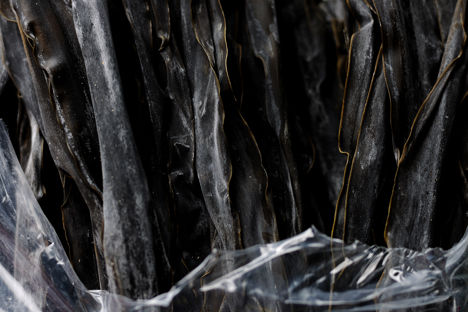
Seafood of Japan: seaweed
There are a huge number of different seaweeds eaten in Japan, and each one is delicious and delightful in its own way. Check out our guide below to learn how to tell the difference between aonori and nori, and some of our favourite ways of enjoying these slippery sea vegetables.
Seafood of Japan: seaweed
There are a huge number of different seaweeds eaten in Japan, and each one is delicious and delightful in its own way. Check out our guide below to learn how to tell the difference between aonori and nori, and some of our favourite ways of enjoying these slippery sea vegetables.
Seaweed is eaten in so many forms in Japan – shredded into cloud-like ribbons, mixed with octopus in salads and simmered in stews and stocks. But, outside of Japan, the only Japanese seaweed most people know of is nori, the shiny black laver used to wrap sushi and onigiri. However, while nori is undeniably versatile and delicious, the world of seaweed is far broader than nori alone.
In Japanese cuisine, seaweed is sourced from all over the archipelago. The best kombu is said to come from the cold waters of northern Hokkaido, while Okinawa is known for its love of vinegary mozuku. Seaweed is used in refined Edomae sushi to wrap delicate nigiri, but also sprinkled with abandon on street food like takoyaki and okonomiyaki. Its popularity with the older generation of Japanese people is pointed to as the source of their longevity, but it’s just as keenly devoured by the younger generation in the form of ‘Gohan desu yo’ seaweed spreads and crunchy nori crisps. Seaweed, Japanese cuisine proves, is for everyone. Read on to learn more about how to cook with different types, and give a new seaweed a go.
Kombu
After nori, kombu is probably the most well-known form of seaweed in Japanese cooking. It is a key component of dashi, the light stock used as the base for a great many Japanese dishes. Good kombu is worth its weight in gold – almost literally. The most high-end forms of kombu, like rausu and rishiri kombu, are costly. But given that a good dashi is critical to Japanese cooking, it’s definitely worth the money.
When kombu is finely shredded into gossamer-like ribbons, it’s known as tororo kombu. This is used as a filling for onigiri or a topping for noodle soups. Shio kombu is an intensely salty type of the seaweed, which has been cut into thicker slivers and is mixed with vegetables for a punchy, savoury side dish.
In the recipe below, Miho Sato uses kombu to cure her hotate.
Nori
Nori is the shiny, black seaweed used to wrap the outside of sushi rolls (maki-zushi) and onigiri. It’s used in all sorts of different forms – finely shredded and sprinkled on top of eggs, nestled into a bowl of ramen or fried and coated with punchy, salty seasonings.
Nori is unusual amongst Japanese seaweeds in that it is a processed form of seaweed. Sheets of nori are made from several different species of red algae that are pulped and then dried in sheets, like paper. Red algae is the same group of seaweed that Welsh laverbread and Irish dulse come from.
Aonori
When cooked, wakame has a soft, slippery texture. It’s usually prepared from dried wakame which expands to many times its original size. Only a small pinch is needed to add texture and a distinctly oceanic punch to miso soups. The wakame used in soups generally comes from the leaf of the plant, but the crunchy stem, known as kuki wakame, is popular in salads. Mekabu is the name for wakame from the very base of the plant, and it is generally sold finely shredded.
Wakame
This type of seaweed is made from green algae, and generally comes in a powder or in fine flakes. If you’ve ever seen green powdered seaweed sprinkled on top of okonomiyaki or takoyaki, or bought some crunchy senbei or crisps that are speckled with green seaweed, it was probably aonori, rather than nori.
Aonori is also used in shichimi togarashi, a Japanese spice blend which incorporates citrus peel, chilli peppers, sansho and sesame seeds, as well as flecks of seaweed. It’s delicious on top of noodle soups, or in dressings and sauces.
Mozuku
Mozuku is not particularly well known outside of Japan. Mozuku is less likely to be cooked with than the other ingredients on this list, and instead is generally eaten simply with a sanbaizu dressing, and sometimes mixed with cucumbers. Sanbaizu is a popular Japanese dressing made from three parts vinegar, two parts soy sauce and one part sugar.
Mozuku is a traditional food in Okinawan cuisine, and like lots of Okinawan ingredients – such as the purple sweet potato – is touted within Japan as a health food, even more so than other forms of seaweed.
Apart from these traditional preparations, seaweed is delicious in simple everyday dishes. Sheets of nori can be scrunched up and sprinkled on top of scrambled eggs, kombi-rich dashi adds an extra dimension to vegetarian soups, whilst aonori can bring some extra oomph to battered foods and fritters. So don’t be afraid to experiment, and add an extra sprinkling of Japanese seaweed to your cooking.


